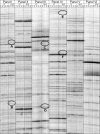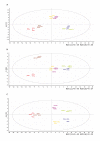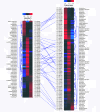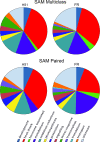Temperature stress differentially modulates transcription in meiotic anthers of heat-tolerant and heat-sensitive tomato plants
- PMID: 21801454
- PMCID: PMC3162933
- DOI: 10.1186/1471-2164-12-384
Temperature stress differentially modulates transcription in meiotic anthers of heat-tolerant and heat-sensitive tomato plants
Abstract
Background: Fluctuations in temperature occur naturally during plant growth and reproduction. However, in the hot summers this variation may become stressful and damaging for the molecular mechanisms involved in proper cell growth, impairing thus plant development and particularly fruit-set in many crop plants. Tolerance to such a stress can be achieved by constitutive gene expression or by rapid changes in gene expression, which ultimately leads to protection against thermal damage. We have used cDNA-AFLP and microarray analyses to compare the early response of the tomato meiotic anther transcriptome to moderate heat stress conditions (32°C) in a heat-tolerant and a heat-sensitive tomato genotype. In the light of the expected global temperature increases, elucidating such protective mechanisms and identifying candidate tolerance genes can be used to improve breeding strategies for crop tolerance to heat stress.
Results: The cDNA-AFLP analysis shows that 30 h of moderate heat stress (MHS) alter the expression of approximately 1% of the studied transcript-derived fragments in a heat-sensitive genotype. The major effect is gene down-regulation after the first 2 h of stress. The microarray analysis subsequently applied to elucidate early responses of a heat-tolerant and a heat-sensitive tomato genotype, also shows about 1% of the genes having significant changes in expression after the 2 h of stress. The tolerant genotype not only reacts with moderate transcriptomic changes but also exhibits constitutively higher expression levels of genes involved in protection and thermotolerance.
Conclusion: In contrast to the heat-sensitive genotype, the heat-tolerant genotype exhibits moderate transcriptional changes under moderate heat stress. Moreover, the heat-tolerant genotype also shows a different constitutive gene expression profile compared to the heat-sensitive genotype, indicating genetic differences in adaptation to increased temperatures. In the heat-tolerant genotype, the majority of changes in gene expression is represented by up-regulation, while in the heat-sensitive genotype there is a general trend to down-regulate gene expression upon MHS. The putative functions associated with the genes identified by cDNA-AFLP or microarray indicate the involvement of heat shock, metabolism, antioxidant and development pathways. Based on the observed differences in response to MHS and on literature sources, we identified a number of candidate transcripts involved in heat-tolerance.
Figures








References
-
- Drews GN, Goldberg RB. Genetic control of flower development. Trends in Genetics. 1989;5(8):256–261. - PubMed
-
- Aarts MG, Hodge R, Kalantidis K, Florack D, Wilson ZA, Mulligan BJ, Stiekema WJ, Scott R, Pereira A. The Arabidopsis MALE STERILITY 2 protein shares similarity with reductases in elongation/condensation complexes. The Plant Journal. 1997;12(3):615–623. doi: 10.1046/j.1365-313X.1997.d01-8.x. - DOI - PubMed
-
- Ariizumi T, Hatakeyama K, Hinata K, Sato S, Kato T, Tabata S, Toriyama K. A novel male-sterile mutant of Arabidopsis thaliana, faceless pollen-1, produces pollen with a smooth surface and an acetolysis-sensitive exine. Plant Molecular Biology. 2003;53(1-2):107–116. - PubMed
-
- Chen YC, McCormick S. sidecar pollen, an Arabidopsis thaliana male gametophytic mutant with aberrant cell divisions during pollen development. Development. 1996;122(10):3243–3253. - PubMed
Publication types
MeSH terms
Substances
Associated data
- Actions
LinkOut - more resources
Full Text Sources
Molecular Biology Databases

